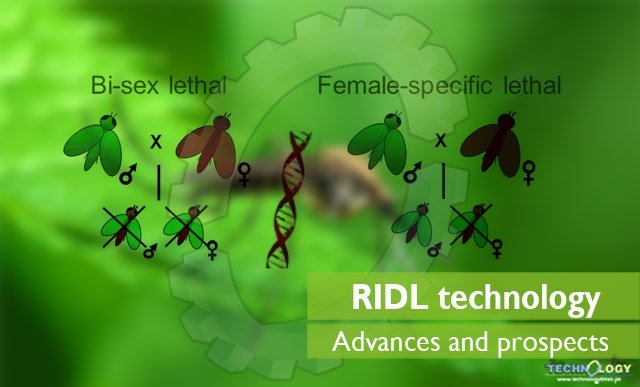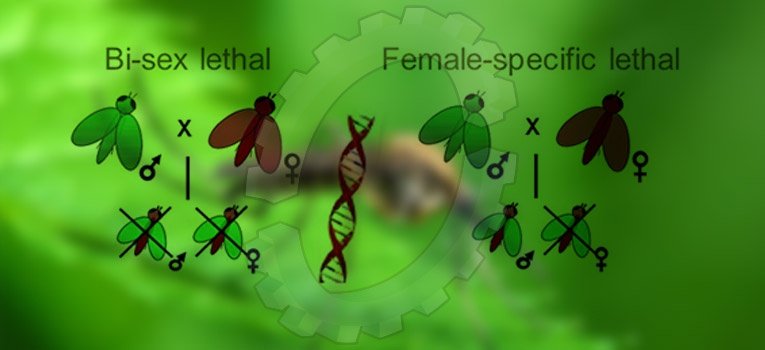Release of Insect carrying Dominant Lethal gene – RIDL technology is just like Sterile Insect Technique (SIT). In this technology male population exposed to irradiation and after that male population is released into field then sterile male mate with female population and ultimately no viable eggs produced. So it’s a best insect pest control technique in which lethal genes inserted through molecular biology.

In RIDL technology male population carry a lethal gene and that lethal gene become a part of genome of the male insect. When that male insect mate with female then offspring’s are developed. These offspring’s are dies before maturity rather the zygote transformation into a baby. This young one at initial embryonic stages dies don’t develop into adults. But in male SIT technology no offspring’s are developed.
RIDL technology first time developed from Oxitec Company just to tackle mosquito or control different diseases which are dengue. Oxitec company is a largest company that manage RIDL of Pink bollworm, RIDL of fruit fly. Oxitec stands for Oxford Insect Technology, developed by Oxford University.
Aspects
- Eco-friendly technique
- Species-specific technique there genes not stay into environment
- Name of lethal genes different for different insects. The gene that is specific for mosquito will not be activated in Pink bollworm.
- Save for natural enemies if any predator eat mosquito that have this lethal gene that predator will not die not transcript a toxic protein.
- Save for higher animals if RIDL insects eaten by higher animals these genes not work.
Principle
Insects have specific cell machinery which consist of DNA and genes each and every gene regulate or transcript a specific protein in form of enzymes that protein has specific function or regulate specific cell part. The pest control gene produces a protein called tTAV (tetracycline transactivater variant) or main dominant lethal gene.
This tTAV gene produce a protein bind with specific site of DNA of cell machinery of young one and that specific site called TeTO (tetracycline operator). When tTAV transcribe into TeTO it produce millions of tTAV. When RIDL male insect mate with female and in zygote formation genomic material, it transcribe both of paternal and maternal sides. So that tTAV gene enter into a genomic of new born baby and bind to a TeTO of genome of that baby. It produce many tTAV and these tTAV bind with each and every cell machinery of young one.
tTAV produce millions of toxic proteins, that block cell machinery of young one. Consequently, metabolic failure and system is completely block, so that young one ultimately die.
Antidote for RIDL technology male insects
Tetracycline is an antidote that is used in factories and in rearing units its act like a switch and turn off the tTAV to produced further more toxic proteins. This antidote bind with tTAV protein and disables it. When tetracycline enter into body of young one it block the transcription of this gene. This gene not bind with TeTO and not produced toxic proteins. Even if it produce toxic proteins they are in very minor quantity in inactive form and young one can survive.
How this tetracycline injected into body?
Mix these tetracycline into diet of larvae or young one. When they take tetracycline into their body it will keep this gene suppressive. Ultimately young one develop into adult. In case of mosquito Aedes aegypti they can multiply large number of mosquitoes. Specific population that are not fed on diet they have tetracycline antidote. They are RIDL male insects and population that fed on diet having tetracycline they normally survive and multiply and produce huge reproduction. It’s a pre-genic process apply in one generation and appear into next generation.
Markers and monitoring
All of Oxitec’s strains contain a heritable fluorescent marker to distinguish them from other native insect pests and this is helpful for scientist for management of insect pests. Effective monitoring is the key for management of all insect pests programs. In this way we can apply right treatment at right time for better control of insect pests.
It is important to determine whether insects caught in traps are the offspring of released self-limiting ones or fertile wild ones. Wrongly identifying a wild insect as self-limiting means an infestation may fail.
In other insect pest control programs, such as sterile insect technique, insects are mark with fluorescent dusts or food dye which are not always easily identifiable on insects recovering from field traps and may fade with age. In this case of incomplete sterility do not pass on to the next generation. Oxitec’s strains contains certain genes that fluorescent when viewed under certain filters.
This article is collectively authored by Aqsa Arshad1*, Asim Munawar1, Muhammad Ishaque Mastoi2, Waqas Wakil1, Faiza Usman3._1Department of Entomology, University of Agriculture Faisalabad, Pakistan. 2Department of Plant Protection, NARC, Park Road Islamabad. 3Department of Plant Breeding and Genetics, University of Agriculture Faisalabad.

